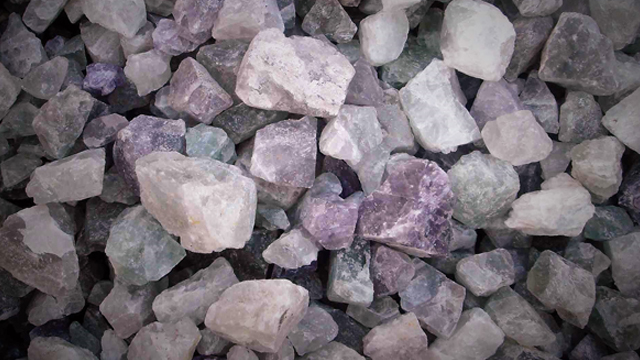Big Chemistry: Hydrofluoric Acid [Hackaday]

For all of the semiconductor industry’s legendary reputation for cleanliness, the actual processes that go into making chips use some of the nastiest stuff imaginable. Silicon oxide is nothing but boring old sand, and once it’s turned into ultrapure crystals and sliced into wafers, it still doesn’t do much. Making it into working circuits requires dopants like phosphorous and boron to give the silicon the proper semiconductor properties.
But even then, a doped wafer doesn’t do much until the unwanted bits are etched away. That’s a tall order, though; silicon dioxide is notoriously tough stuff, largely unreactive and therefore resistant to most chemicals. Only one substance will do the job: hydrofluoric acid, or HFA. HFA has a bad reputation, and deservedly so, notwithstanding its somewhat overwrought treatment by Hollywood.
It’s corrosive to just about everything, it’s extremely toxic, and if enough of it gets on your skin it’ll kill you slowly and leave you in agony the entire time. But it’s also absolutely necessary to make everything from pharmaceuticals to cookware, and it takes some big chemistry to do it safely and cheaply.
Going With The Flow
Understanding the industrial importance and production of hydrogen fluoride requires a close look at the fluoride side of the molecule. Like chlorine and bromine, fluorine is one of the halogens, and as such has a high electronegativity, or the tendency to attract shared electrons in chemical bonds. As the most electronegative element, fluorine is very reactive, so much so that it forms bonds with almost every other element on the periodic table.
Fluorine compounds fall into two broad categories: organic and inorganic. Both categories have a wide range of industrial uses. Organic fluorides are compounds where fluorine is bound to carbon; while this is technically a covalent bond where electrons are shared between two atoms, fluorine’s pull on the carbon electrons is so strong that it gives the C-Fl bond ionic characteristics. This tends to make organic fluorides, like polytetrafluoroethylene (PTFE, or Teflon), very stable compounds, leading to their industrial usefulness. Stability is a double-edged sword, though; fluorocarbon solvents and refrigerants like Freon can persist for decades in the upper atmosphere, and perfluorooctanoic acid (PFOA) is classified as a persistent organic pollutant or “forever chemical” with toxic properties.

For as many uses as organic fluorides have, and for as much of them as we produce, the vast majority of global fluoride production is in the form of inorganic fluorides, and the majority of that is dedicated to the production of metal. Fluoride compounds such as calcium fluoride, also known as fluorite or fluorspar, have been used as a flux in steelmaking for centuries; fluorine takes its name from the Latin fluor, to flow. Thanks to its reactivity, the fluorine in fluorspar binds to impurities in the steel mix, floating it to the surface as a slag that can be removed. About half of the world’s fluorspar production goes into steelmaking, with most of the rest going into aluminum production in the form of synthetic cryolite, a compound of sodium, fluorine, and aluminum that is used as an electrolyte to lower the melting point of alumina in bauxite ore.
Inorganic fluorides also play a huge role in the petroleum industry, where fluorine serves as a catalyst for alkylation, the process of adding alkyl groups to smaller, lighter hydrocarbons. Alkylation is used to turn the three-carbon compound isobutane into alkenes such as propylene and butylene, which are precursors to plastics such as polypropylene and butadiene, the “B” in ABS. Inorganic fluorides are also making a splash in the battery industry, with lithium hexafluorophosphate (LiPF6) becoming more important as an electrolyte for lithium batteries.
None of these compounds, though, would exist if it weren’t for the two million tons of hydrogen fluoride we turn out each year, in the form of anhydrous hydrogen fluoride (AHF). AHF is a gas at room temperature, but when chilled slightly it condenses into HF, a liquid that’s miscible in water. Aqueous solutions of HF are called hydrofluoric acid, and are generally the form used for industrial processes to produce most of the organic and inorganic fluorides listed above. Hydrofluoric acid is also broadly used as a cleaner, solvent, and etchant in industrial processes, particularly in the manufacture of integrated circuits.
It Takes Acid to Make Acid
Fluorine is a fairly abundant element, making up 13% of the Earth’s crust by mass. Because it reacts with so many elements, there are a lot of fluoride-containing minerals, like fluorspar, which is the main feedstock for industrial-scale hydrogen fluoride production.
Like many big chemistry processes, the reaction that produces hydrogen fluoride is quite simple. The details, however, require some careful chemical engineering and strict process control, along with a lot of specialized equipment:
Fluorspar is treated with sulfuric acid, creating hydrogen fluoride and calcium sulfate, which in hydrated form is known as gypsum. But before any of that can happen, fluorspar has to be mined and preprocessed. Most fluorspar deposits have a fairly low concentration of the mineral trapped in unwanted rock material, or gangue. To increase the relative concentration of fluorspar to gangue, raw ore goes through a process called beneficiation, where it’s crushed into a fine powder and mixed with water and surfactants. Air is pumped into the mixture, creating bubbles that the gangue adheres to while the fluorspar sinks. The enriched fluorspar goes through several rounds of froth flotation and drying until it gets to the proper concentration — about 97.5% pure fluorspar for acid production feedstock. Fluorspar used for flux in steelmaking or to make cryolite only needs to be between 60% and 84% pure.
Anhydrous hydrogen fluoride production starts in a prereactor, which is charged with dry acid-grade fluorspar. Sulfuric acid, which is produced from sulfur recovered from natural gas processing, is pumped in, along with oleum, or fuming sulfuric acid (SO3). The combined reactants are pumped into a rotary kiln, which is indirectly heated with steam. The kiln needs to be heated because the reaction of sulfuric acid and calcium fluoride is strongly endothermic; the heat drives the reaction to completion.
Raw hydrogen fluoride gas leaves the rotary kiln and passes through a series of filtration and purification steps. The goal here is to remove any fluorspar particulates and sulfuric acid aerosols in the gas, as well as to dehydrate the raw gas as much as possible with condensers and distillation. Anhydrous hydrogen fluoride can then be stored as a gas, or more commonly, diluted with water to form hydrofluoric acid at a variety of concentrations tailored to downstream processes.
Like everything destined for the semiconductor fab plant, the hydrofluoric acid used for etching silicon wafers has to be as close to contaminant-free as possible. Electronics-grade hydrofluoric acid is made by diluting AHF with ultrapure water to a final concentration of about 50%. Total cationic contamination has to be less than 10 parts per billion, meaning that each liter must have less than 10 micrograms of anything other than hydrogen, oxygen, and fluorine.
A Healthy Apatite
Another major source of hydrofluoric acid is as a byproduct of phosphoric acid production. Phosphates are a major plant macronutrient — it’s the “P” in the familiar “NPK” rating on fertilizers — and in a world with 8 billion mouths to feed, mountains of phosphate fertilizers are made every year. Phosphoric acid is the chief feedstock for fertilizer manufacturing, along with being important as a food additive, in lubrication and metal treatments, and of course as a dopant and etchant in semiconductor manufacturing.
Phosphoric acid is manufactured from phosphate-containing minerals such as calcium hydroxyapatite (Ca5(PO4)3OH), the same mineral that makes bones and dental enamel hard, and fluorapatite (Ca5(PO4)3F). Both minerals, together known simply as apatites, are found in phosphate rocks all over the world; commercially viable deposits are few and far between, though.
Extracting the apatite ores involves typical mining processes followed by similar beneficiation steps used in fluorspar manufacture. Phosphoric acid can be created from sufficiently enriched apatite by treating it with sulfuric acid:
It’s a very similar reaction to that used in AHF production, but the desired product is the phosphoric acid (H3PO4), which goes through extensive filtration and purification processes. The gaseous HF that’s produced is just a waste product, albeit one valuable enough to be recovered. This is accomplished with a wet scrubber, which treats the HF-containing flue gasses with a fine spray of water. The HF readily dissolves in water, making it easy to recover. The aqueous solution goes through further filtration and distillation processes to reach the final desired purity and strength.
Poisons While It Burns
The descriptions of the chemical processes used to liberate fluorine from minerals are greatly simplified, of course, and almost nothing about handling AHF and hydrofluoric acid on industrial scales is trivial. Hydrofluoric acid, while chemically classified as a weak acid thanks to its inability to dissociate completely into H+ and F– ions in solution, is anything but weak in practical terms. Hydrofluoric acid is corrosive in the extreme, quickly destroying most metals, many plastics, and even glass. Only certain polymers, like certain polyethylenes and fluoropolymers like Teflon, are resistant to HFA; unfortunately, materials like these are difficult to use in industrial settings, especially where high temperatures and pressures are needed. Certain nickel alloys like Monel are resistant to hydrofluoric acid, meaning that a lot of the reaction vessels and piping are used in hydrogen fluoride plants.
And as if hydrofluoric acid’s corrosivity weren’t enough, it’s also extremely toxic. Hydrofluoric acid burns in the lab or plant are very dangerous; as soon as the acid breaks down the integrity of the epidermis, the fluoride ions begin to bind to anything they can find, with particular affinity for calcium and magnesium ions in tissues. These ions are vital for the electrochemical reactions of the nervous system, meaning that with enough of a dose, fluorine ions can quickly stop your heart. Immediate washing followed by rapid medical intervention is required to avoid a gruesome and painful death.

![big-chemistry:-hydrofluoric-acid-[hackaday]](https://i0.wp.com/upmytech.com/wp-content/uploads/2024/02/170487-big-chemistry-hydrofluoric-acid-hackaday-scaled.jpg?resize=800%2C445&ssl=1)